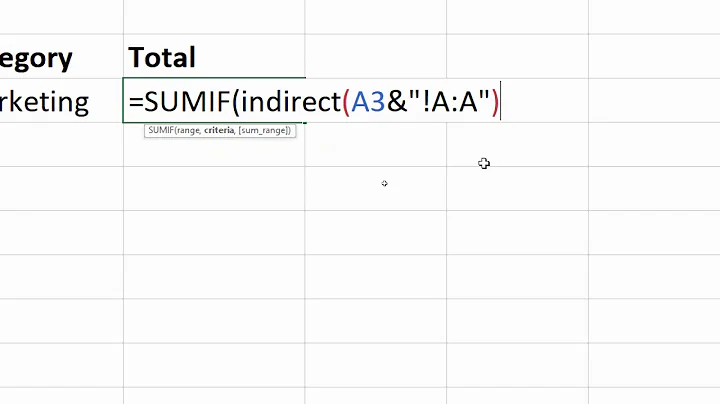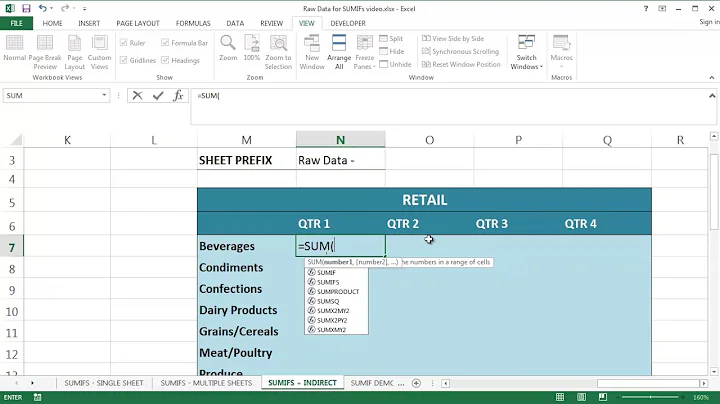How to use INDIRECT with SUMIFS for criteria range?
Your formula returns an error because the ranges in a Sumifs need to be the same size, but the first range is of variable length, due to the construction with Indirect(), whereas the second range is a fixed range.
Indirect() is one possibility to build variable ranges, and you can apply the same technique to the second range, like this:
=SUMIFS(INDIRECT("$B"&$B9):INDIRECT("$B"&$B10),INDIRECT("$A"&$B9):INDIRECT("$A"&$B10),D$11)
Note that I added $ signs for the B9 and B10 references, so the column does not change when the formula is copied across.
Be aware that Indirect is volatile, though and excessive use of it in large workbooks can lead to slowness. Another way to write the formula is with the non-volatile Index(), like this:
=SUMIFS(INDEX($B:$B,$B9):INDEX($B:$B,$B10),INDEX($A:$A,$B9):INDEX($A:$A,$B10),D$11)
Related videos on Youtube
Damian
Updated on September 18, 2022Comments
-
Damian over 1 year
I'm working on an excel sheet that has an elastic range. Instead of using A:A as a range, I want to use INDIRECT and 2 cells to determine the range.
Currently I'm stuck with this =SUMIFS(INDIRECT("$B"&B9):INDIRECT("$B"&B10),$A$12:$A$33,D$11)
What would be the correct way to use INDIRECT to determine a range with 2 cells?
-
 Admin over 7 yearsWhat's wrong with the formula you wrote?
Admin over 7 yearsWhat's wrong with the formula you wrote? -
 Admin over 7 years@fixer Maybe that it does not work???
Admin over 7 years@fixer Maybe that it does not work??? -
 Admin over 7 years@teylyn, I was focused on the INDIRECT and didn't even catch that. Good answer.
Admin over 7 years@teylyn, I was focused on the INDIRECT and didn't even catch that. Good answer.
-
-
Damian over 7 yearsThe main sheet I'm working on has some 150K rows, you gave me more than I asked for and I thank you! The reason why I was thinking of using a variable range is because of performance.
-
teylyn over 7 yearsSumifs() is super fast and is happy to process whole columns. No need to jump through hoops to restrict the range you feed it, in fact, that might adversely impact performance. In any case, if that solved your issue, please mark it as the answer as described in the Tour
-
Damian over 7 yearsIn the sheet I'm working on, I'm trying to reference the INDEX on another page, the original code is this: =COUNTIFS('Stay Data'!$A$2:$A$200000,'Stay Report'!$A6,'Stay Data'!$F$2:$F$200000,">="&$A$1,'Stay Data'!$F$2:$F$200000,"<="&$B$1,'Stay Data'!$P$2:$P$200000,'Stay Report'!D$5)
-
Damian over 7 yearsI'm trying to do this: =COUNTIFS('Stay Data'!Setup!index($B:$B,$B$31):index($B:$B,$B$32),'Stay Report'!$A6,'Stay Data'!Setup!index($B:$B,$B$31):index($B:$B,$B$32),">="&$A$1,'Stay Data'!Setup!index($B:$B,$B$31):index($B:$B,$B$32),"<="&$B$1,'Stay Data'!Setup!index($B:$B,$B$31):index($B:$B,$B$32),'Stay Report'!D$5) How do I do this portion correctly 'Stay Data'!Setup!index ?
-
Damian over 7 yearsI've tried using sumifs with an entire range using A:A but that affected performance badly. Do you have any suggestions for rows about 200,000?
-
teylyn over 7 yearsPlease don't ask follow-up questions in comments. Your question was answered, so please mark the answer. Then start a new question.






